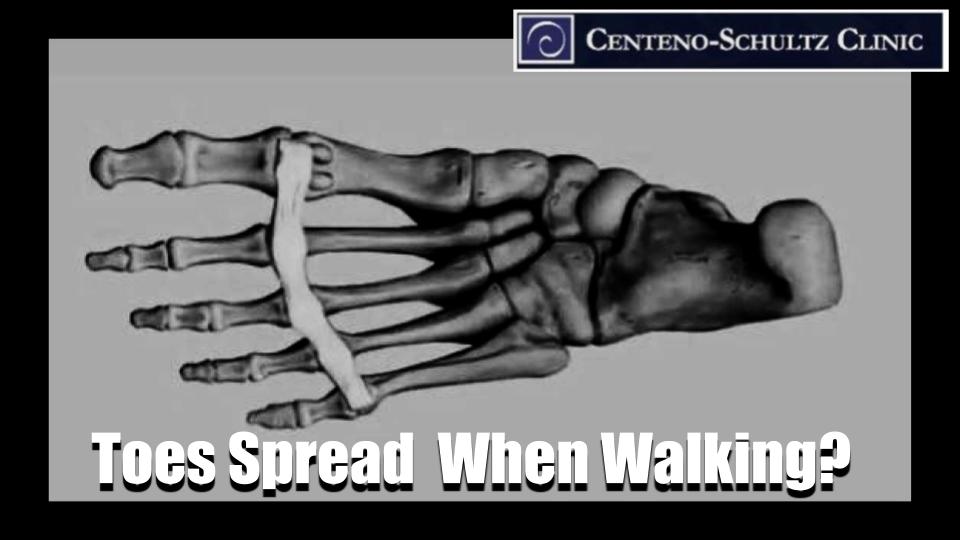Most of us probably don’t think too much about our toes and feet…that is, until something goes wrong. However, what does it mean when your toes spread when you walk? If you’re worried about your splayed toes or splayed feet, you’ve come to the right place. Let’s dig in.
Your Toes Spread When You Walk?
Our feet are a critical and first line of defense between ground force and the rest of the body. As the foot and toes strike the ground, the energy is transferred up the kinetic chain, to our ankles, knees, and so on, gradually losing force as the energy travels upward. So it’s easy to see that the feet bear the brunt of that force, and when there is a problem in the feet or toes, those forces can bypass this weak link and wreak havoc on those other structures. One common problem in the foot and toes has to do with the ligaments. If, for example, your toes spread out when you walk, this could be a sign that you have instability in the forefoot due to lax, or loose, ligaments. And, yes, it’s something you want to address as ignoring instability can only make matters worse. Before we explain, watch Dr. Centeno’s video below for more about your splayed feet problem.
The Transverse Metatarsal Ligament Is the Great Forefoot Stabilizer
The transverse metatarsal ligament is a band of tissue that lives in the forefoot. Ligaments connect bone to bone, and this ligament stretches across (or “transverses”) the forefoot from side to side and connects the metatarsals, the five bones that end at our toes. This ligament holds the bones firmly in place, providing just enough flexibility to allow our feet to move properly and “spring” a bit as we walk. Along with the muscles, the ligaments help provide stability and support to the foot.
What Happens When the Transverse Metatarsal Ligament Becomes Loose: Your Splayed Toes
If the transverse metatarsal ligament becomes loose (imagine a stretched rubber band), it loses its ability to provide proper stability and support to the metatarsals. This can cause problems with walking, further injure the foot, and can also create problems in additional structures of the lower limb, such as the knee and hip as when the foot is unable to absorb those ground forces as it was designed to do, too much force is moved up the leg and into structures that weren’t designed to handle it. Just the excessive and unnatural motion of an unstable forefoot (as you can see in the video above) with a loose ligament can create unnatural forces in other structures.
As mentioned earlier, one sign of forefoot instability due to a loose transverse metatarsal ligament is your toes spread out as you walk as the ligaments can no longer keep the metatarsals firmly connected. If you aren’t sure what this looks like, be sure to watch the video above, which shows this issue as Dr. Centeno examines a patient.
Tightening the Transverse Metatarsal Ligament Without Surgery
If your toes spread out like the patient’s in the video, you don’t need to see an orthopedic surgeon; loose transverse metatarsal ligaments can be tightened without surgery. Your interventional orthopedic physician can perform advanced precise injections of orthobiologics that can tighten up those loose ligaments. This is a complex procedure, however, and it is imperative that you see a physician specifically and extensively trained in these types of injections of the ligament. If our clinic here in Colorado is not close to you, you can find physicians with this training who have mastered these advanced interventional orthopedic procedures through the nonprofit organization, the Interventional Orthopedics Foundation.
If your toes spread out when you walk, this is often caused by an unstable forefoot due to a loose transverse metatarsal ligament. Addressing the issue sooner rather than later is critical to protecting other lower-limb structures that jump in to take up the slack when the forefoot can’t properly absorb and minimize ground forces. This additional workload on these structures over time can lead to further problems, such as arthritis in toes and other structures as well as joint pain.
A simple test by your interventional orthopedic physician, who is trained to not only recognize but treat lax ligaments, can determine if you have forefoot instability due to a loose transverse metatarsal ligament and take care of your splayed toes or splayed feet problem before it turns into a bigger problem!

